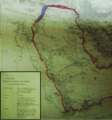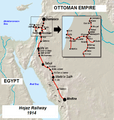Arab Revolt facts for kids
The Arab Revolt was a big uprising by Arab tribes against the Ottoman Empire during World War I. The British Empire, who were also fighting the Ottomans, helped the Arabs with military support. Many Arabs involved in the revolt hoped to create one large, independent country for all Arab people. However, this dream did not come true, and the Arab lands were later divided into many different countries.
Contents
What Was the Arab Revolt?
The Arab Revolt was a major event that happened between 1916 and 1918. It was a fight for freedom by Arab people living under the rule of the Ottoman Empire. The Ottoman Empire was a very large and powerful empire that had controlled many Arab lands for centuries.
Why Did the Arabs Revolt?
For a long time, many Arabs felt that the Ottoman Empire treated them unfairly. They wanted more control over their own lives and lands. As World War I began, the Ottoman Empire joined the side of Germany and Austria-Hungary. This made the situation even more difficult for the Arabs.
- Many Arabs wanted to be independent from the Ottoman Empire.
- They dreamed of forming a single, united Arab nation.
- The Ottoman government was becoming more focused on Turkish nationalism, which made Arabs feel left out.
Who Led the Revolt?
The revolt was mainly led by Hussein bin Ali, who was the Sharif of Mecca. He was a very important religious and political leader in the Hejaz region (part of modern-day Saudi Arabia). His sons, especially Faisal and Abdullah, also played key roles in leading the Arab fighters.
British Support
The British Empire saw an opportunity to weaken the Ottoman Empire during World War I. They decided to support the Arab Revolt. The British provided money, weapons, and advice to the Arab fighters. A famous British officer named T. E. Lawrence, also known as "Lawrence of Arabia," became a close advisor to Prince Faisal and helped plan many attacks.
Key Events and Battles
The Arab Revolt started in June 1916. The Arab fighters used guerrilla warfare tactics. This means they used surprise attacks and ambushes instead of large, open battles.
- June 1916: The revolt officially began in Mecca. Arab forces attacked Ottoman garrisons (military bases) in the Hejaz region.
- 1917: The Arabs focused on disrupting the Hejaz railway. This railway was very important for the Ottomans to move troops and supplies. By blowing up parts of the railway, the Arabs cut off Ottoman forces.
- July 1917: One of the most famous victories was the Battle of Aqaba. Arab forces, led by Prince Faisal and T. E. Lawrence, captured the port city of Aqaba. This was a very important victory because it gave the Arabs a port on the Red Sea.
- September 1918: The Arab forces, fighting alongside British troops, captured Damascus. This was a major city and a big step towards ending Ottoman rule in the region.
After the Revolt
The Arab Revolt played a part in the defeat of the Ottoman Empire in World War I. However, the dream of a single, united Arab country did not come true.
- The British and French had made secret agreements during the war to divide the Middle East between themselves. This was known as the Sykes–Picot Agreement.
- After the war, the lands that the Arabs had fought for were divided into new countries under British and French control. For example, areas like Iraq, Jordan, and Palestine came under British influence, while Syria and Lebanon came under French influence.
- This division led to many problems and conflicts in the Middle East that continue even today.
The Arab Revolt is an important part of history. It shows how people fought for their freedom and independence. Even though the goal of a united Arab nation wasn't achieved, the revolt helped shape the map of the modern Middle East.
Images for kids
-
Lawrence at Rabegh, north of Jeddah, 1917
-
Lawrence of Arabia after the Battle of Aqaba.
-
Arab fighters in Aqaba on 28 February 1918. Autochrome colour photograph.
-
Feisal party at Versailles Conference. Left to right: Rustum Haidar, Nuri as-Said, Prince Faisal (front), Captain Rosario Pisani (rear), T. E. Lawrence, Faisal's slave (name unknown), Captain Hassan Khadri.
-
The Aqaba Flagpole holding the flag of the Arab Revolt, commemorating the site of the Battle of Aqaba.
See also
 In Spanish: Rebelión árabe para niños
In Spanish: Rebelión árabe para niños









